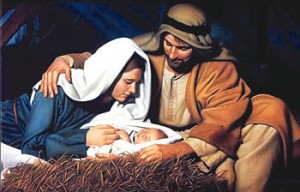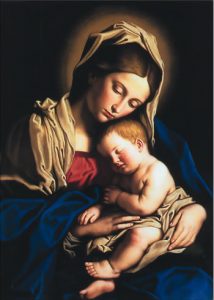Mary for Today: Mary in the Year of Faith:
‘Always a Virgin’
Theology and Physicality: This belief comes from tradition rather than Scripture or a definitive council. Only the virginal conception of Jesus is directly mentioned in the New Testament, where the emphasis is placed not so much on Mary or on virginity as such, but on Jesus and the great new event signified by the virginal conception that prefigures his birth. The first question we have to ask is why do Matthew and Luke give us such an account of the origins of Jesus? What message are they giving us? The secondary topic is the perpetual virginity of Mary.
There is no scriptural intention of devaluing the normal God-given means of conception and birth, but a clear theological message is being sent that no human power could cause the Son of God to become human; Jesus Christ comes to us, completely and utterly as God’s gift, from the God we call ‘our Father’ and ‘Holy Spirit’– or he comes not at all! If we stop only at the physical level of the teaching we get into questions that were never part of the original inspired Scriptures, e.g. women as seed bed and men as suppliers of the full genetic material, i.e. the ancient understanding of conception. Or how did the baby emerge without the rupture of the hymen, virginity during childbirth? The gap between the world of Mary and our own can be bridged only with caution and sensitivity.
The Message: Tertullian, an influential early theologian, resisted the idea of perpetual virginity; there was even a saying that went as far as to say that perhaps because the message of the angel was heard by ear, the child was born through the ear. No wonder St. Jerome would have none of what he termed the ‘delirious nonsense’ of the popular Protoevangelium of James, with its image of elderly Joseph and Jesus’ half-brothers. We will gain far more appreciation if we look to the spiritual symbolism behind the tradition rather than focus on the physical details! This will get us nearer to a critical and neglected aspect of the teaching on Mary’s perpetual virginity. When Jesus gave us his beatitudes, one of them was “Blessed are the clean of heart,” better translated as, “Blessed are those of undivided heart.” As first disciple of Jesus, Mary stands foremost as one whose undivided heart was centred on her Son, virginity of heart (and body). We all know what is to be torn between many different desires. The theological concern of the text is the fact that Mary’s virginity speaks of her holiness, of her being receptive to the Holy Spirit.
Israel is called ‘Virgin Israel’ to symbolise her sacredness. The holiness of a people becomes focussed in one person, Mary, the new Daughter Zion. The involvement of the Spirit in the account should remind us of the creative power of the Spirit at work ‘in the beginning.’ The creative Spirit stands at the beginning of the Old Testament and now is at work in the birth of the New. God wills a renewed creation in Christ and the creative Spirit is at work again.
... a clear theological message is being sent that ... Jesus Christ comes to us, completely and utterly as God’s gift ...
From Womb to Tomb: There is an integrity about the Christian message and our God. The Resurrection is its most critical aspect (1 Cor. 15:13-14). The God we believe in brings life out of empty wombs and empty tombs. The gospel begins with a barren Elizabeth and a virgin, Mary. Both represented a state of unfulfilled potential in the mentality of the times. It is because of the lives of Jesus and Mary that the virginal state of life entered Christianity as something to be honoured and lived with faithfulness (and not a little difficulty!) If some of this sounds true for fidelity in married life also it is because both married life and single life stand before God as equally noble forms of life.
Behind this teaching lies a whole unfortunate complex of thinking on original sin, that Jesus could never be conceived in the normal human way while it was held that original sin was communicated by procreation (Augustine). Then Jesus was preserved from it by the absence of a human male parent. Karl Rahner asked that questions involved in the virgin birth be thought afresh and that a distinction be made between what is the essential content of faith and what belongs to a secondary level.
Church Fathers and Church Councils: What was not affirmed in Scripture certainly featured in following postbiblical literature, notably the second century ‘Protoevangelium of James’. Mary’s virginity was extended to virgin before, during, and after birth, that Mary remained a virgin all her life. Now we have the Protoevangelium’s account of the brothers and sisters being the children of Joseph by an earlier marriage (hence the statues of Joseph, an elderly carer for the young mother, and the absence of the husband of Mary from the canon of the Mass until after 1961 and regrettably, his absence from the recent ones!). With the flexibility given to Hebrew language, Jerome says they were cousins of Jesus. Among the Church Fathers, Athanasius, Augustine and Cyril joined their support for the perpetual virginity of Mary with that of Jerome.
The universal acceptance of Mary’s perpetual virginity came to be widely accepted from the third century on. By now consecrated virgins had become established as a special state in the Church, and Mary was presented to them as their model in holiness. The Council of the Lateran (649) mentioned the virginity of Mary. The Council of Constantinople II (553-554) twice referred to Mary as “ever-virgin.
Conclusion: This is a doctrine for which there is no convincing evidence other than it is a tradition of the Church. It involves the virginal conception of Jesus and the perpetual virginity of Mary. The gentle and respectful conclusion of Fr. Raymond Brown, at the end of his work on the ‘Virginal Conception and Bodily Resurrection of Jesus’ (1973) serves as a caution: “as we discuss Mary’s virginity, we must assure all those ordinary people in our churches, the ‘little people’ who happen to be God’s people, that in our quest we ‘experts’ have not forgotten that we too must obey the biblical injunction (Luke 1:48) that all generations, even this ‘nosey’ generation, shall call her blessed.”
References: Brown, R. E. et al. Mary in the New Testament; Coyle, Kathleen. Mary in the Christian Tradition.



 Entries(RSS)
Entries(RSS)